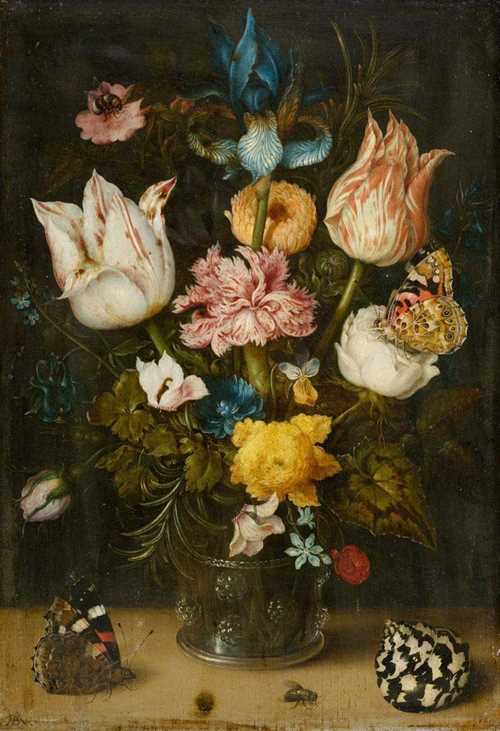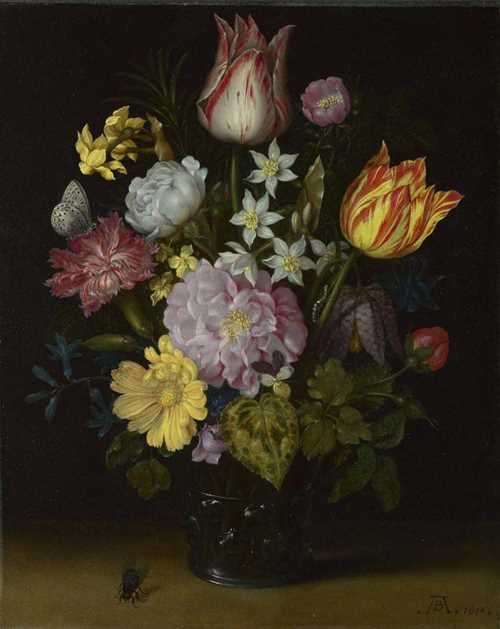
Lot 3014* - A146 Old Master Paintings - Friday, 19. September 2008, 02.30 PM
AMBROSIUS BOSSCHAERT the Elder
Provenance:
- Private collection, Germany, since the 19th century.
- thence by descent.
This exquisite and exceptionally well-preserved flower still life recently came to light in a private collection in Europe. Its discovery is important, as the painting not only provides an excellent and characteristic example of Ambrosius Bosschaert the Elder 's first mature work, making it a welcome addition to his oeuvre, but it also appears to be one of the earliest independent still lives painted in the Northern Netherlands in the 17th century.
What is most striking about the painting is the wonderful simplicity of its composition and the technical perfection with which it was executed. Each flower and butterfly, as well as the shell, is painted with scientific precision; the copper support gives the colours their maximum richness, thereby lending a jewel-like appearance to the whole object.
The precision of the painterly technique has been applied in equal measure to the construction of the composition, which is dominated by a vertical axis formed by the iris at the top, the carnation in the centre and the yellow flower just above the rim of the roemer, which anchors the whole composition. The two tulips are arranged either side of the central axis, counterbalanced by the butterfly and the shell on the ledge below.
As observed by Fred Meijer (Ploeg, P. van der: Bouquets from the Golden Age, 1992, p. 62, under cat. no. 6), tight compositional schemes around a vertical axis are found in all of Bosschaert's early works. Examples are the painting of 1606 in Cleveland (see Ill. 1, cp. Brenninkmeijer - de Rooy, B.: Bouquets from the Golden Age, 1992, p. 16. fig. 2 or Chong, A./ Kloek, W.: Still - Life Paintings from the Netherlands 1550 - 1720, 1999, pp. 117/ 8, cat. no. 5, with ill.) and that of 1607, formerly with John Mitchell & Son, London (Ploeg, P. van der, op.cit., cat. no. 6). However, in contrast to these two works, the present picture shows an important shift in Bosschaert's development, that distinguishes it from earlier works. He now contrives to surround the flowers with more air and space. Thus, instead of placing the vase and flowers close to the picture plane with a limited sense of depth, as in his previous still lives, he now positions the roemer further back, allowing the vase to stand in an illusory space.
This development must have taken place in about 1608/9, as it also occurs in the flower still life, signed and dated 1608, that was offered at Sotheby's London in 1995, and is now in a private collection. As observed by Fred Meijer, that painting not only renders space in a way very similar to the present picture, but it also features the same roemer. This led Meijer to conclude that both works must date from the same time and that the last digit of the date should be read as an 8.
As Fred Meijer has further pointed out (verbally), Bosschaert's search for more spacious compositions was probably influenced by Jan Brueghel I, who had started to paint independent flower still lives on small copper plates in around 1606, the first one for Cardinal Federico Borromeo in Milan. Although the relationship between Bosschaert and Brueghel remains unclear - was Bosschaert a pupil, or did he know Brueghel only in his capacity as an art dealer? - it is striking to note that the still life by Jan Brueghel I, now in the Städel Museum in Frankfurt, inv.no. 1219 (Sander, J.: Die Magie der Dinge. Stillebenmalerei 1500 - 1800, exhibition catalogue 2008/9, cat.no. 21, with ill.), shows an identically positioned cyclamen and also the motif of the leaf over the rim of the roemer that appears in the present painting. Yet, as has been often observed, the result in Brueghel's case tends to be very different from Bosschaert's. Where the former's bouquets are always playful and light, the latter's are characterised by tranquillity and precision.
The quest to create spatial effects continued to preoccupy Bosschaert in subsequent years. This becomes evident from the small flower still life of 1610, in the P. and N. de Boer Foundation, Amsterdam (Segal, S.: Flowers and Nature, 1990, p. 188, no. 33, with ill.) and also the flower still life of 1614, in the National Gallery, London (see illustration 2). In the latter work especially, the bouquet is organised in a looser compositional structure with the flowers bending forwards and backwards to articulate the surrounding space. In his later years, for example in the picture now in the Mauritshuis, The Hague, inv. no. 679 (Ploeg, P. van der, op.cit., cat. no. 8, with ill.), Bosschaert introduced the motif of the open niche, obviously with the intention of enhancing the overall sense of spaciousness.
As was originally pointed out by L.J. Bol (The Bosschaert Dynasty. Painters of Flowers and Fruit, 1960, p. 20 ff.) and subsequently by B. Brenninkmeijer - de Rooij and others ('For Love of Flora', in: Ploeg, P. van der, op.cit., p.11), and has since been supported with evidence by Dr Sam Segal, who has carried out much research in this field over the last decades, Bosschaert's floral still lives could never have existed in real life, since the flowers comprising his bouquets blossomed at different times of the year. The diagram identifying the various specimens in the present picture, drawn up by Dr Sam Segal, confirms this observation. Tulips, for example, do not flower at the same time as roses.
In his research Dr Sam Segal moreover demonstrated that Bosschaert's bouquets always consist of highly unusual types of flowers, as described in florilegia by Rembert Dodoens (Dodonaeus), Charles de l' Escluse (Clusius), Adriaen Collaert and others, and that their depiction should therefore be understood in the light of a particular humanist culture (see Segal, S.: Flowers and Nature, 1990, cat. no. 13-16, with ills.).
Indeed, as L.J. Bol (op. cit., p. 15 ff.) has pointed out, the town of Middelburg where Bosschaert lived, was home to numerous amateur botanists who tried to grow plants and special breeds of flowers in their gardens and who must have used such florilegia as their handbooks. The lively correspondence between some of these collectors and Carolus Clusius, director of the Botanical Garden at Leyden University, shows how passionate these men were in their eager pursuit of information about new plant species and growing methods. The environment created by these botanical collectors has often been cited as the most important stimulus for the creation of the still life genre as a separate category in Dutch painting at the beginning of the 17th century. Surely, these amateur botanists must have been the first collectors of Bosschaert's still lives, marvelling at the faithful way in which the artist had rendered the different types of flowers in floral arrangements that were merely an illusion of reality. As Fred Meijer has observed (verbally), it is presumably for this reason that the flowers in Bosschaert's compositions tend to be life-size.
The illusionistic possibilities of art first caused excitement in 16th-century court circles, where humanist interest stimulated courtiers to explore the visual reality. Gardening and botany were highly recommended as useful activities, while collections of all sorts of naturalia and artificialia were assembled to create microcosms of the visual world. These collections would contain treasures ranging from bones and shells to works of art, and were shown to visitors, who were meant to marvel at them.
Emperor Rudolf II in Prague is known to have created one of the most important collections of naturalia and artificialia in his "Wunderkammer". In an ambitious programme known as the "Dürer Renaissance", Rudolf invited artists to come to Prague to study and depict the rich flora and fauna of Bohemia. Numerous studies resulted that were subsequently assembled in folders such as the one, now in the Österreichische Nationalbibliothek, containing studies by Ludger Tom Ring, Hans Hoffman and others (see Koreny, F.: Albrecht Dürer und die Tier-und Pflanzenstudien der Renaissance, 1985, pp. 240 / 4, cat. no. 88/9, with ills).
After the death of Rudolf II, the culture he had instigated spread across Europe. In every town and city collectors set themselves the task of creating comparable ensembles of artefacts.
In the meantime painting had gained the status of a liberal (=intellectual) art and was regarded as playing a major role in the humanist culture of the day. This revaluation of painting from craft to science began in 14th-century Italy, where it led to a number of theoretical treatises, the two most important being De Pittura by Leon Battista Alberti, published in 1435, and Leonardo da Vinci's observations on the role of the artist. Both writers invited visual artists to represent nature. Drawing and painting not only came to be seen as scientifically meaningful activities, but also necessary as a means of approaching the creative power of nature itself, given that artists themselves were part of this creative force.
At the end of the 16th century, these Renaissance theories, which had first been developed in Padua and Florence, were brought to the north, by among others Karel van Mander, who published his Schilderboeck in 1604. His writings introduced the idea of the independent genres, to which Dutch painting was to contribute so widely.
Little is known about the life of Ambrosius Bosschaert I, but he is counted with Jan Brueghel I, Roelant Savery and Jacob de Gheyn among the pioneers of the independent genre of still life painting in the first decade of the 17th century. He was born in Antwerp in 1573; in 1587 his family moved for religious reasons to Middelburg, where he appears to have stayed until 1613, joining the painters' guild in 1593. In 1614 Bosschaert was recorded in Amsterdam, and from 1615/9 in Utrecht; thereafter he was recorded in Breda. He died in 1621 while on his way to deliver a painting in The Hague.
Although he was highly sought after in his own days, Bosschaert's reputation as an important painter of still lives faded in the course of the 18th and 19th century. By the beginning of the 20th century, he had sunk almost into oblivion, until L.J. Bol (op.cit, 1960) lifted him from obscurity and made a first attempt to reconstruct his oeuvre. Both Dr Sam Segal ('Still-Lifes by Middelburg Painters', in Masters of Middelburg, 1984, and other subsequent publications) and Fred Meijer (Stillevens uit de Gouden Eeuw, 1989, and other contributions to catalogues) have since considerably added to our knowledge of the artist, so that the painting presented here can now be given its proper assessment, as a unique example of still-life painting of the Dutch Golden Age.
We would like to thank Fred G. Meijer from the RKD, The Hague and Dr. Sam Segal for the help in cataloguing this lot. We also thank Marjorie E. Wieseman for giving us the opportunity to compare this lot next to the flower still-life by Ambrosius Bosschaert in the National Gallery, London.
Fred G. Meijer will kindly give a lecture on this lot here in Zurich on Wednesday 10 September 2008 at 19:00.
CHF 2 500 000 / 3 500 000 | (€ 2 577 320 / 3 608 250)
Sold for CHF 5 770 000 (including buyer’s premium)
All information is subject to change.




